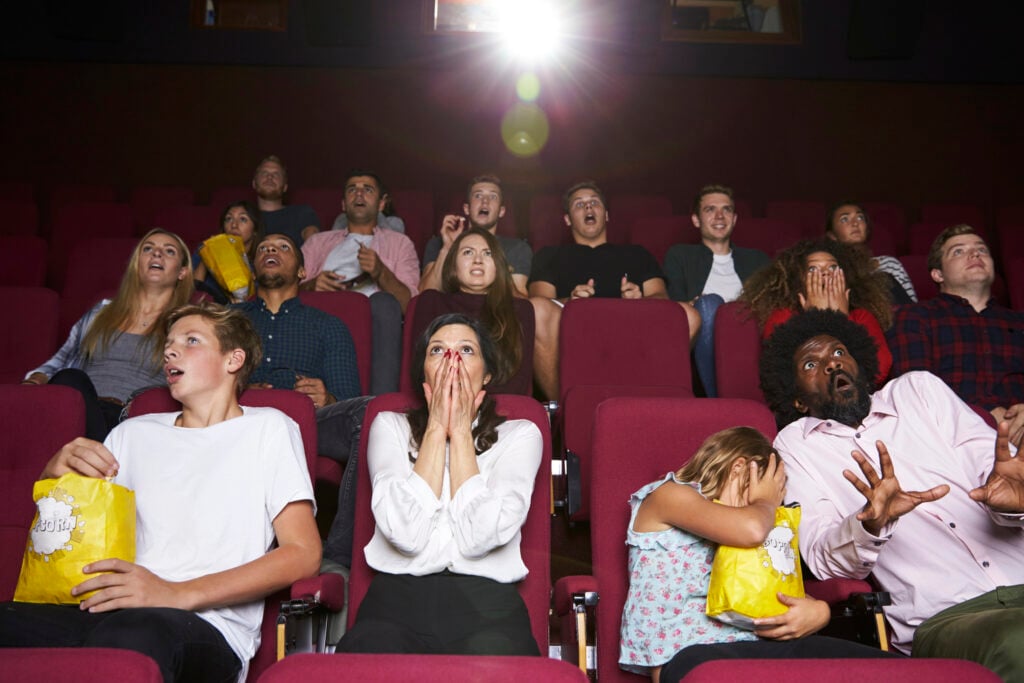
2027 is shaping up to be a big year in movie theatres. Fox has recently announced a second Simpsons movie for July, the second part of the Avengers Doomsday/Secret Wars epic from Marvel hits theatres in December, and of course, The Heeler Family hits the big screen in the Bluey movie in August of that year.
There might be a slight hitch in studios reaping the benefits of these huge franchises, though. What if no one went to see them?
My family and I were once regular visitors to our local multiplex, making sure to be there on opening night for movies like Paw Patrol: The Movie, The Wild Robot, and Inside Out 2. But things have changed. In 2025, we went to the theatre twice, and both times were at the tail end of big movie runs, in small theatres that offer discount tickets and comfortable seating.
So what happened? Going to the movies was practically a weekly occurrence, and then it just stopped. The pandemic obviously hit everyone hard in terms of being able to go out and do things, but why wouldn’t going to the movies bounce back?
Cost, Comfort, And Convenience Of Going To The Movies
The first reason, most obviously, is the cost. As theatres struggled to recoup losses from the pandemic years, ticket and concession prices soared. The cost to take my family of four to a movie, along with popcorn and such, ballooned to almost $100 at Cineplex, our regional chain theatre.
According to industry data tracker The Numbers, the average price of a movie ticket has increased by more than 68% over the past 20 years. The price of a movie ticket in the year 2004 was $6.21, and now, in 2024, the average cost is $10.78.
To cut costs, theatres began eliminating in-house restaurants and arcades, so while concession prices rose, quality declined. An increase in pre-show advertisements and tie-ins (popcorn boxes come to mind) was overkill and not appealing.
Finally, it just wasn’t comfortable to go to a movie. Theaters had been building bigger spaces with more seats for decades, but now they remain mostly empty and cavernous (which is kinda scary to a little kid sometimes), and the seats are jammed together and increasingly uncomfortable to sit in for long periods.
The convenience of streaming services, the ease of piracy, and what’s seen as a decline in movie quality have also contributed to this decline. When I took an informal poll of a few friends, I found that their number one reason for not wanting to go to the movies was that they didn’t want to spend the money and then have the film turn out to be a stinker.
Kids and Teenagers Aren’t Going To The Movies

Beyond taking my family to the movies, when I was a teenager and in my 20s, going to see a film was just what we did on Friday nights. The Movie theatre (or the mall it was in) was a social hangout as well as a place for entertainment. All of the latest blockbusters, classic re-releases and smaller art films were all consumed due to long theatrical runs that gave my friends and I time to check them all out.
Today, though, for teenagers, there are hundreds of things that are more appealing, taking up their time and money. Interactive open-world games, social media, and shrinking attention spans and allowances are all keeping kids and teenagers at home. Parents and Teens have less disposable income than ever, and in a lot of cases, movies aren’t in the cards.
Actress and Producer Reese Witherspoon recently told Variety that she has seen this trend in her household as well. “I noticed my kids weren’t going to the movies,” Witherspoon said. “I had teenage kids. I went to the movies every Friday and Saturday night. Kids don’t go to the movies… Attention spans are shifting. The way we make movies is going to change radically in the next two to three years.”
While AI and other advances may make movies easier or cheaper to make, will major studios know what to do with them?
Major Studios Are Their Own Worst Enemy
The hard truth is something that the major production studios (Disney, Warner, Paramount, Amazon, Netflix, etc) don’t like to admit: they’ve lost the ability to reach people and don’t know how to spend their own money.
Streaming was supposed to be a massive boon to these companies, but none have figured out how to make it profitable. Streaming also presents a delicate balance between commerce and art that most have not yet achieved. Hits like KPop Demon Hunters are infrequent and one that Netflix was entirely unprepared for.
Animated movies like The Wild Robot and Transformers One were acclaimed by critics and fans alike, but they did not perform well at the box office, mainly due to the reasons mentioned previously. So, the studios that made them see them as failures and are unlikely to develop sequels, cutting off budding fans and fandoms that want more of these worlds.
Finally, studios spend almost as much as a movie’s budget on marketing and promotion. For example, 2023’s The Super Mario Bros. Movie cost Illumination $100 million to make, but they then spent $150 million to promote and market the movie. Do they honestly think it takes $150 million to get people interested in a film about one of the most beloved video game and pop culture characters of all time?
In the case of the Mario Brothers Movie, it went on to be profitable and one of the year’s top money makers. But how many other movies have failed to have that kind of success?
Overall Industry Decline

A few years ago (in the “before” times of 2017), I was working as a Comic Book retailer and worked out a promotion with Warner Bros., capitalizing on the DVD/Blu-ray release of Justice League. The movie was barely in theatres, but they had crates of DVDs to send me. I asked why, and was told that the average theatrical cycle of a movie was now less than three months, due to piracy and declining interest as plot details leaked online.
According to Box Office Mojo, that trend slowly continued but wasn’t heeded as much of a concern because in 2019 (the last year before the pandemic closed movie theatres and much of our daily lives), nine out of ten top-grossing movies cracked $1 Billion at the box office, including the monolithic Avengers: Endgame that brought in $2.7 Billion.
Theatres managed to open as soon as they could in our COVID-riddled world, but between 2020 and 2022, revenues were obviously down, and only four movies reached $1 billion. In 2023 and 2024, five films grossed over $1 billion, and this year, the only North American film to surpass that total has been the remake of Disney’s Lilo & Stitch.
Sure-thing tentpole movies like Superman, The Fantastic Four: First Steps, and Mission Impossible – The Final Reckoning, which in the past would have been box-office juggernauts, all limped past $500 million in theatres.
Are We Witnessing The Demise of Movies?
As someone who spent the last seven years working in it, I don’t think the movie industry will disappear anytime soon. What I do hope, though, is that Studios start remembering their primary duty is to entertain the audience and not prop up shareholders.
The decline of large multiplex-style theatres could lead to an uptick in smaller, more arthouse theatres, exposing people to a wider variety of movies. The Streaming Genie can’t be put back in the bottle, but special-event theatrical releases can entice even the most lapsed audiences back to the big screen.
People still love going to the movies; they’ve just got to make it fun again, especially for kids and teenagers.
